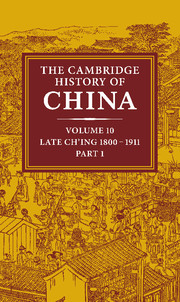Book contents
- Frontmatter
- 1 Introduction: the old order
- 2 Ch'ing Inner Asia c. 1800
- 3 Dynastic decline and the roots of rebellion
- 4 The Canton trade and the Opium War
- 5 The creation of the treaty system
- 6 The Taiping Rebellion
- 7 Sino-Russian relations, 1800–62
- 8 The heyday of the Ch'ing order in Mongolia, Sinkiang and Tibet
- 9 The Ch'ing Restoration
- 10 Self-strengthening: the pursuit of Western technology
- 11 Christian missions and their impact to 1900
- Bibliographical essays
- Bibliography
- Genealogical chart
- Glossary
- Index
5 - The creation of the treaty system
Published online by Cambridge University Press: 28 March 2008
- Frontmatter
- 1 Introduction: the old order
- 2 Ch'ing Inner Asia c. 1800
- 3 Dynastic decline and the roots of rebellion
- 4 The Canton trade and the Opium War
- 5 The creation of the treaty system
- 6 The Taiping Rebellion
- 7 Sino-Russian relations, 1800–62
- 8 The heyday of the Ch'ing order in Mongolia, Sinkiang and Tibet
- 9 The Ch'ing Restoration
- 10 Self-strengthening: the pursuit of Western technology
- 11 Christian missions and their impact to 1900
- Bibliographical essays
- Bibliography
- Genealogical chart
- Glossary
- Index
Summary
PERSPECTIVES ON THE TREATY SYSTEM
The unequal treaty system was set up in China at a time when the Chinese common people did not participate in a national political life. In the middle decades of the nineteenth century they were still schooled in the traditional ways of Confucian culturalism: government was an affair of the emperor and his officials, supported by the local élite. A modern type of nationalism received little expression under this old order. Instead, the Ch'ing regime was primarily concerned to retain the loyalty of the Chinese landlord-scholar ruling class and with its help to suppress any disorder or anti-dynastic rebellion that might arise among the rural populace. In this context the pacification of British rebels on the seacoast was at first a marginal, relatively minor problem. The Ch'ing aim in the late 1830s had been simply to stop an evil, the Anglo-Indo-Chinese opium trade.
This trade, constantly supplied by the British government opium manufacture in India, was to have a life of more than a century, until given up in 1917. The most long-continued and systematic international crime of modern times, it provided the life-blood of the early British invasion of China. For the first war the leading opium traders not only helped Palmerston work out the aims and the strategy, they also supplied some of the wherewithal: opium vessels leased to the fleet, captains lent as pilots and other staff as translators, hospitality always available as well as advice and the latest intelligence, and silver from opium sales exchanged for bills on London to meet the army and navy expenditures.
- Type
- Chapter
- Information
- The Cambridge History of China , pp. 213 - 263Publisher: Cambridge University PressPrint publication year: 1978
- 10
- Cited by



